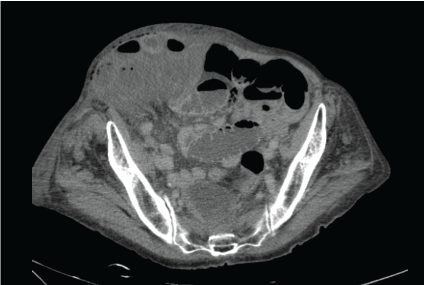The appearance of hernias at laparoscopic trocar incision sites remains one of the unresolved complications of laparoscopic surgery. Closure of these incisions is difficult, and in fact complete closure is not usually achieved. Hernias may appear in the long term or even in the immediate postoperative period, and may be extremely serious. We present two cases of patients who suffered early hernias in the immediate postoperative laparoscopic surgery in trocar incision sites, with serious life-threatening complications. To avoid these complications we recommend closing all orifices made by trocars of 10mm or more with the incorporation of the peritoneum into the fascial closure. The Carter-Thomason device allows hermetic sealing of the components of the wall in order to reduce the risk of hernias.
Hernia/etiology, Port-site hernia, Laparoscopy/adverse effects, Surgical Instruments/adverse effects, Suture techniques.
The appearance of hernias in laparoscopic trocar incisions is a complication unresolved, with an incidence between 1 and 6% [1-3]. We present case reports of two patients who presented early life-threatening site hernias.
Female patient aged 84. No clinical history of note. Admitted for elective surgery due to a complete rectal prolapse.
Laparoscopic ventral mesh rectopexy was performed uneventfully with fascial closure with absorbable suture of the two 12 mm trocars' incisions.
At 48 hours after surgery, reported sudden onset of a painful mass in the right lower quadrant. Computed tomography (CT) revealed herniation of small bowel loops through the trocar incision in the right iliac fossa with signs of low contrast uptake (Figure 1). Emergency surgery identified correct fascial closure and herniation of a large segment of the small intestine in the pre-peritoneal space with signs of necrosis. Intestinal resection and a simple closure of the aponeurosis incorporating the peritoneum were required.
One month later, the patient was readmitted with abdominal pain and a re-emergence of an irreducible mass at thesame level. A second reoperation revealed the opening of the suture containing about 70 cm of viable transverse colon. The defect was repaired with an onlay polypropylene mesh over the suture.
Female patient, 45 years old with BMI (Body Mass Index) of 45.5 kg/m2 and a history of hypertension, hypothyroidism and a previous ineffective sleeve gastrectomy. Admitted for elective surgery for gastric bypass, performed uneventfully via laparoscopic approach. At 48 hours after surgery presented nausea, vomiting, and diffuse abdominal pain. CT (Figure 2) showed a small intestinal hernia through the trocar incision made in the left flank.
Surgery revealed a tear in the fascia suture with protrusion of a small bowel loop, with no signs of suffering. The loop was reduced and the repair uneventfully performed with an onlay mesh.
Laparoscopic has substantially improved patients' postoperative evolution. However, the use of trocars is associated with the emergence of new complications.
To prevent from trocar site hernias the current recommendation is the 10 mm or larger defects closure [1-5]. Special care must be taken in patients with risk factors for trocar site hernia as advanced age [5,6], wound infection [4,6,7] and obesity [4-7].
Early postoperativeherniasare usually severe as they tend to be associated with small bowel obstruction [1,2].
The hernia may protrude through various levels in the components of the abdominal wall [4]. To avoid hernia above the preperitoneal fat, closure of the peritoneum together with the abdominal fascia is recommended [1,2].
More than 15 closing techniques are available. In 2007 Shaher et al. [1] performed a review that established that the Carter-Thomason device achieved significantly faster and safer closure.
To prevent hernias and their potential complications in laparoscopic surgery, we recommend systematic closure of all 10-12 mm trocar incisions, incorporating the peritoneum, at the start of surgery. Using the Carter-Thomason device makes this maneuver simpler and safer. In cases of incarcerated hernia, we recommend repair using a mesh.

Figure 1: Late venous stage abdominal CT. Herniation of small bowel loop and low contrast uptake in the bowel wall.

Figure 2: Venous stage abdominal CT with oral contrast, showing herniation of small bowel loop through the left trocar incision and the proximal dilatation of the bowel loops.